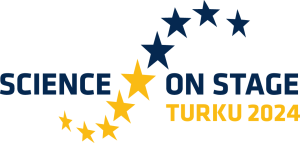Projects on programming, digital education, ICT, Big Data, artificial intelligence, virtual reality, etc.
(T1) Masaryk School in Space, J. Červená (CZ)

Institution: ZS T.G.Masaryka Kutna Hora
Subjects: Physics, computer science/ICT/IT
The project focused on the cooperation of younger (10 years) and older (12 years) classmates with the aim of assembling a stratospheric probe, to photograph the curvature of our planet, to measure temperature, atmospheric pressure, humidity and determining of GPS coordinates during the flight. The launching of the probe we realized thanks to our involvement in the Touch the Universe Project. The students independently obtained funding and applied for a grant, they programmed, came up with a biological experiment, launched the probe in cooperation with their parents and monitored the landing, processed the data at school, and presented the results to the public. They are currently continuing in the Meteorology afterschool club.
(T2) Cells Speaking, E. Urfalı (TR)
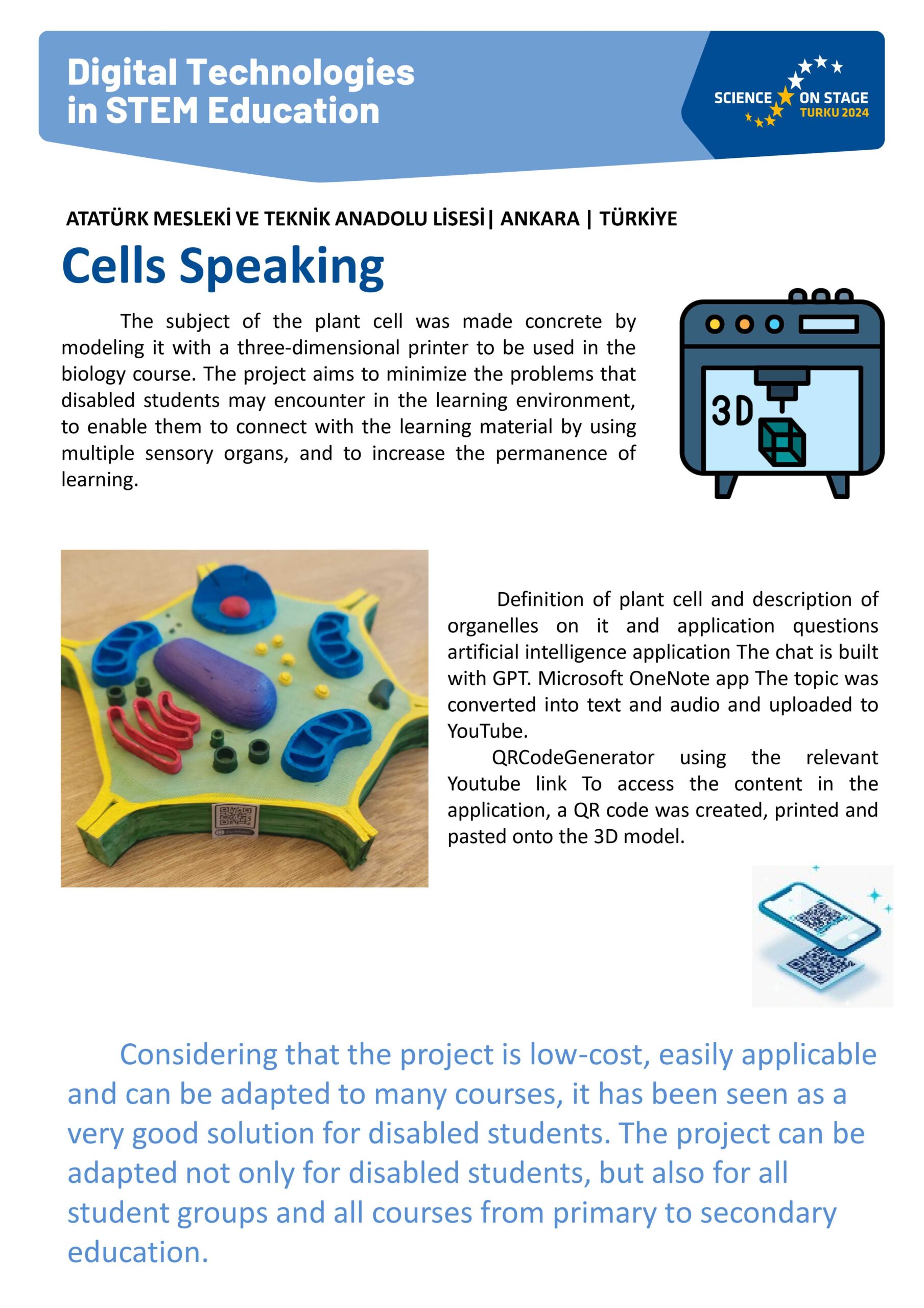
Institution: Ulus Mesleki ve Teknik Anadolu Lisesi
Subjects: Technology, science, design
3D design and the ability to physically print the design and turn their own ideas into concrete models develop students’ imagination. With 3D printers, students can concretize the abstract information they dream of or learn during the course. This project was developed to enable visually and hearing-impaired students to effectively follow curriculum topics, such as biology lessons, and to prepare environments where they can try themselves.
3D modeling of the cell supported by AI is used in biology lessons. This project aims to minimize the problems that disabled students may encounter, to increase the permanence of learning by enabling them to connect with the learning material by using multiple sensory organs.
(T3) Physics of Transportation, L. Apell & J. Paaski (FI)

Institution: Turun klassillinen lukio
Subjects: Physics, engineering, philiosophy, psychology, geography
Physics of transportation is multidisciplinary course for high school students. It combines and applies subjects found from high school curriculum in physics, philosophy, psychology, engineering and geology. Moreover, it emphasize the underlaying themes from normal courses and developes new perspective to utilize knowledge to everyday life, as a part of traffic. Students will visit and get expert knowledge from City of Turku cityplanning office, University of Turku autonomous vehicle development laboratory and Turku University of Applied Science transportation unit and respective planning officers and researchers.
(T4) Solar Battery with Online Dashboard, Y. Guyonnet (FR)
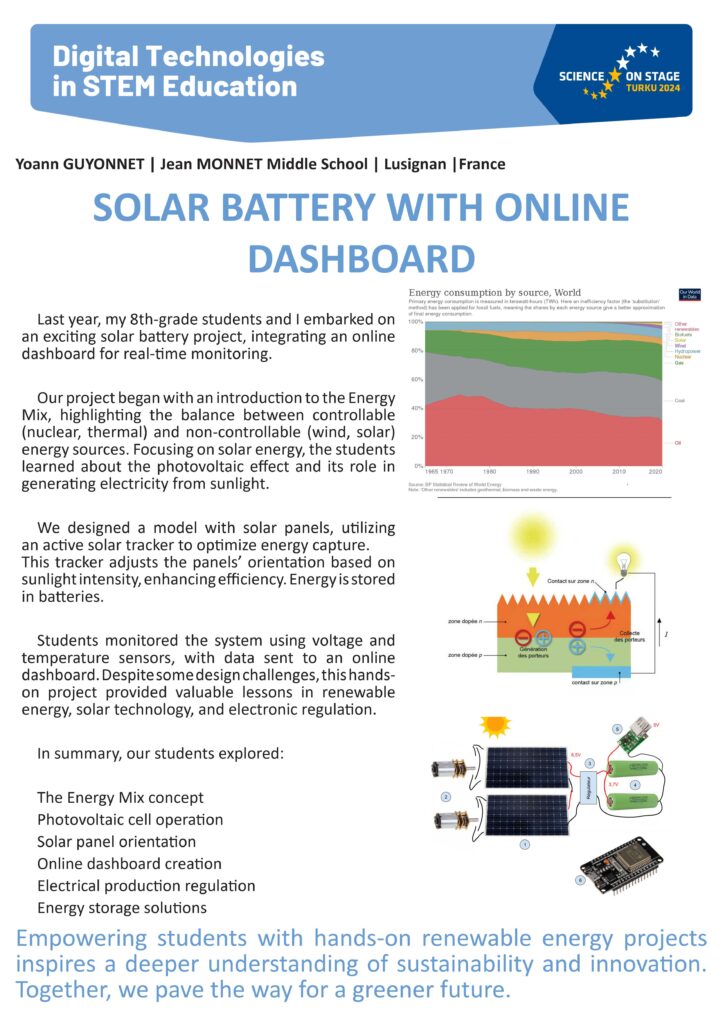
Institution: Collège Jean MONNET
Subjects: Computer science/ICT/IT, technology
In order to recharge a mobile phone during a long hike, the students became interested in the production and storage of energy.
By working through an investigative approach, they were able to explore the concept of an energy mix, the operation of photovoltaic cells, the orientation of solar panels, the regulation of energy production, the creation of a dashboard to monitor production, and found solutions for storing this energy.
(T5) Strange wheels – Incredible movements, from smart omnidirectional mobile robots, P. Poutos (GR)
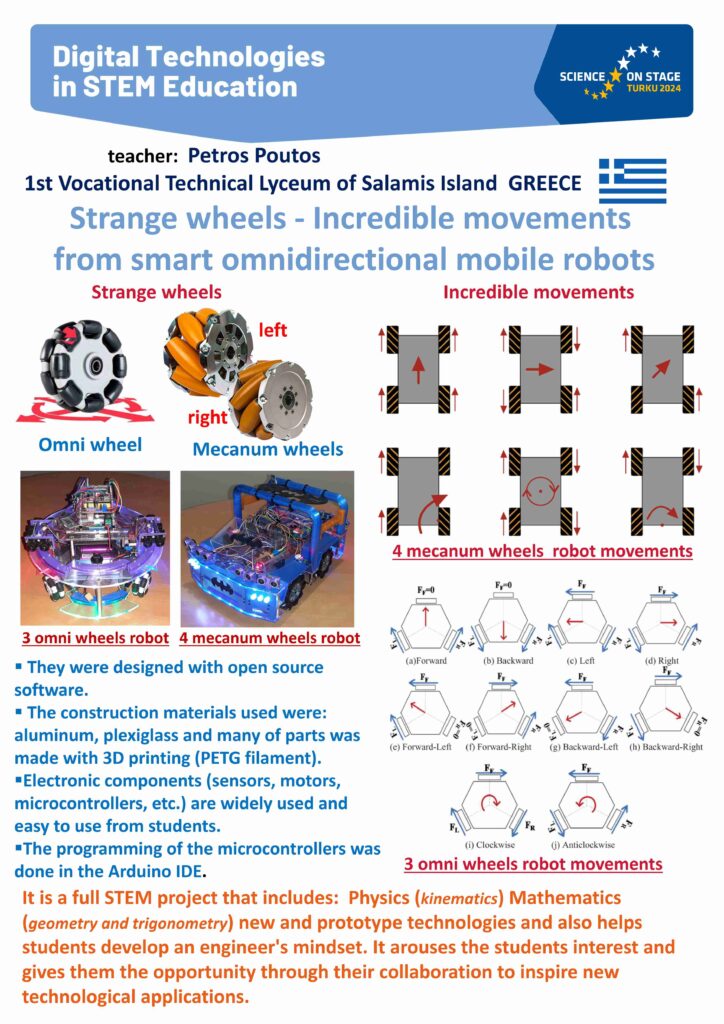
Institution: 1st Vocational Lyceum of Salamis Island
Subjects: Physics, mathematics, computer science/ICT/IT, technology, engineering
This project includes two robots which can move in any direction with unusual movements.They can move either remotely or autonomously. The first has four mecanum wheels with rollers at 45° on their circumference. The motion in each is independent, but they all move at the same speed. The combination of the direction of rotation of each wheel, determines the direction of movement of the vehicle. The second has three omni wheels which have rollers in a parallel arrangement around their circumference. The movement of the wheels is also independent. Unlike the previous one, the wheels move at a different speed and direction and thus, achieve the direction of movement of the vehicle.
(T6) Volcanic Energies, E. Lévai & J. Szabó (HU)
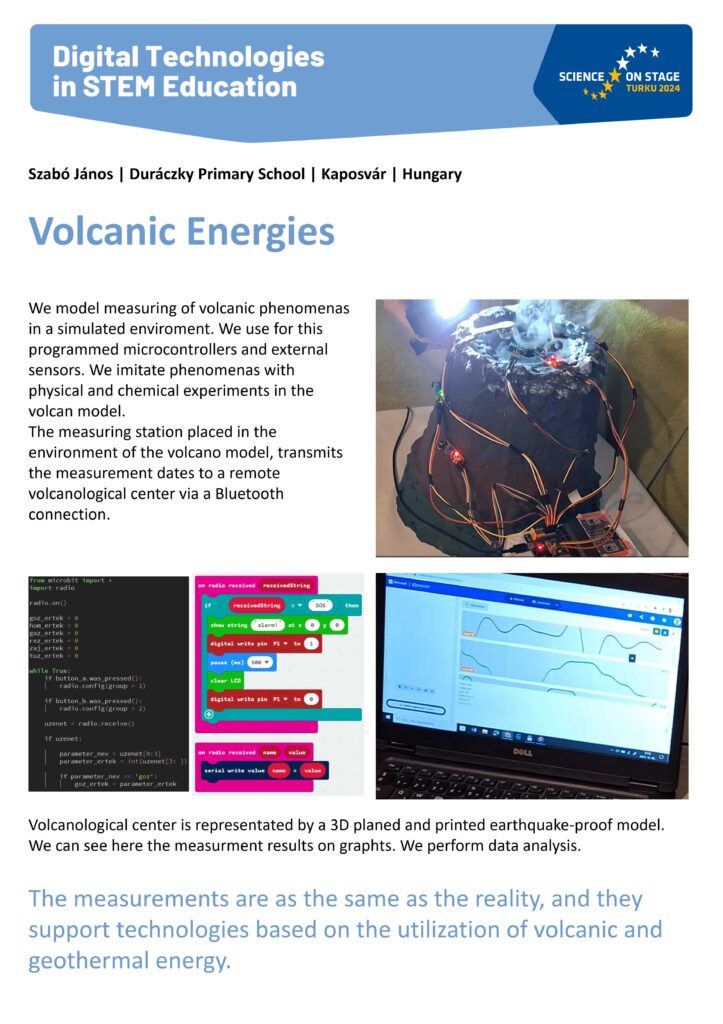
Institution: SM Duráczky EGYMI
Subjects: Physics, chemistry, computer science/ICT/IT, science
We model measuring of volcanic phenomena in a simulated environment. We use for this programmed microcontrollers and external sensors. We imitate phenomena with physical and chemical experiments in the volcano model. The measuring station, placed in the environment of the volcano model, transmits the measurement data to a remote volcanological centre via a Bluetooth connection. The volcanological centre is represented by a 3D planned and printed earthquake-proof model. We can see here the measurement results on graphs. We perform data analysis. These measurements are the same as the reality, and they support technologies based on the utilisation of volcanic and geothermal energy.
(T7) The Art of 3D Design: Where Creativity Meets Technology, H. Gísladóttir & S. F. Jónsson (IS)
Institution: Fjölbrautaskólinn í Breiðholti
Subjects: Computer science/ICT/IT, technology, art and design, innovation
The Art of 3D Design is a fully developed course and a comprehensive collection of learning materials for aspiring digital 3D designers and programmers of all ages. The learning materials consist of an extensive collection of simple to complex projects where the key factors are accessibility, creative thinking and independence. The learning material is designed to be utilised at multiple school levels and is suitable for a diverse student body as well as students with special needs. It’s accompanied by a progress tracker learners use to record and evaluate their own progress. This ensures independence in their work and makes it easy for them to follow the program at their own pace.
(T8) A digital portfolio as a tool for documenting the learning process, M. Monter (FI)

Institution: The City of Helsinki Education Division
Subjects: STEAM, sustainable development
In early childhood education in Helsinki, the activities and learning processes of the group are documented in a digital portfolio. It is a tool for planning, evaluation and development. With the help of the portfolio, the staff reflects on what kind of goals are set for the group’s pedagogical activities and how the children’s participation is realized. In this project carried out with preschoolers, the goal was to get to know the technology and design of old objects, give children the opportunity to invent new things, build learning environments that support inventing, practice using digital tools with children and document the activity in a digital portfolio.
(T9) LAGOrà, I. Tarantino (ITA)
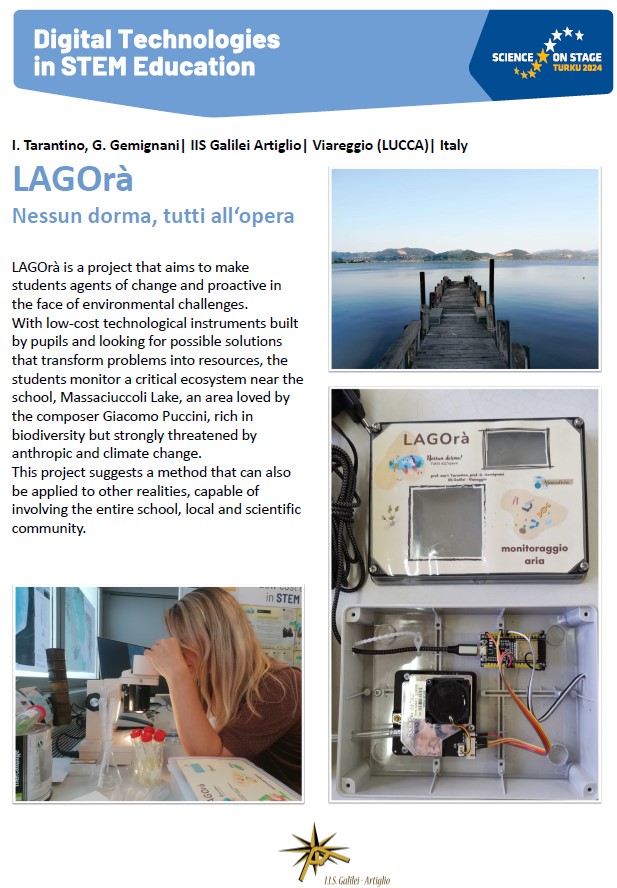
Institution: IIS Galilei – Artiglio
Subjects: Physics, chemistry, computer science/ICT/IT, science, electronics, history, natural history, art, sports
The aim of this project is to involve passionate teenagers in science and technology by involving them in the monitoring of Massaciuccoli Lake’s status of health, a coastal lake near the school. Students not only participated in the monitoring actions, but also built the control instruments (units for detecting air pollutants, pH meters, piezometers) and contributed to producing solutions and data which are essential for setting up environmental remediation campaigns aimed at raising awareness among citizens and institutions. Furthermore, this study lowers eco-anxiety in pupils, involves many subjects and identifies a method that can also be applied to other similar realities in Italy and the rest of the world.
(T10) Positive Impact of Artificial Intelligence on Weather Change, M. Yıldız (TR)

Institution: General Şükrü Kanatlı Secondary School
Subjects: Mathematics, computer science/ICT/IT, technology, science, design
In the project, the aim is to find solutions to the air pollution issue, which creates a negative situation in our world, with the support of artificial intelligence, taking into account the 13th goal, “Climate Action,” within the framework of sustainable development goals. What is crucial here is the modeling of artificial neural networks through design-focused thinking, and brainstorming sessions are conducted with the help of students to gather data. Students actively participated through hybrid learning, engaging in questioning and collaborative learning.
(T11) How to STEM simply, O. Doskochynska (UA)
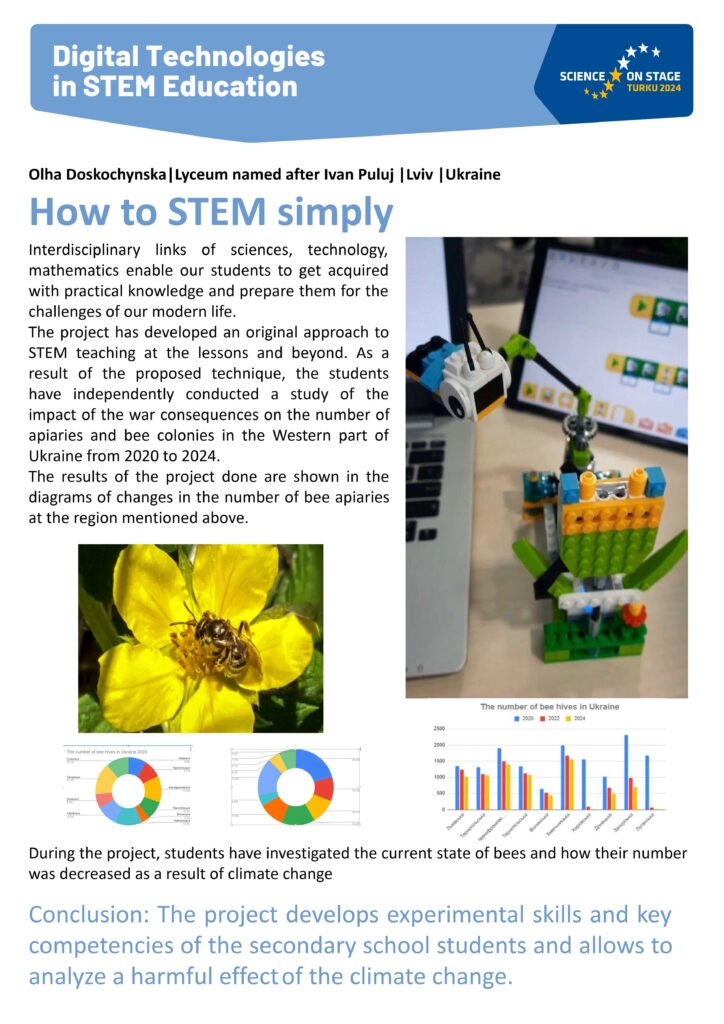
Institution: Lyceum after Ivan Puluj
Subjects: Mathematics, computer science/ICT/IT, technology, art
Using an interdisciplinary approach in my teaching of STEM subjects and art, students are able to learn and acquire practical knowledge, preparing for the challenges of today, through practical hands-on activity. In our projects, we demonstrate how to teach physics, biology and chemistry through simple experiments, combining them with robotics even in elementary school.
One part of the project is the study of plant pollination. We researched the topic, created a robot pollinator bee and investigated the problem of the disappearance of bees in Ukraine.
Another part shows how the human heart can be studied. Using Mozabook 3D models, students created a model of how the heart works and printed it on a 3D printer.
(T12) Is Scratch the answer to a playful and investigative approach to modeling competence in science? S. Petersen (DK)
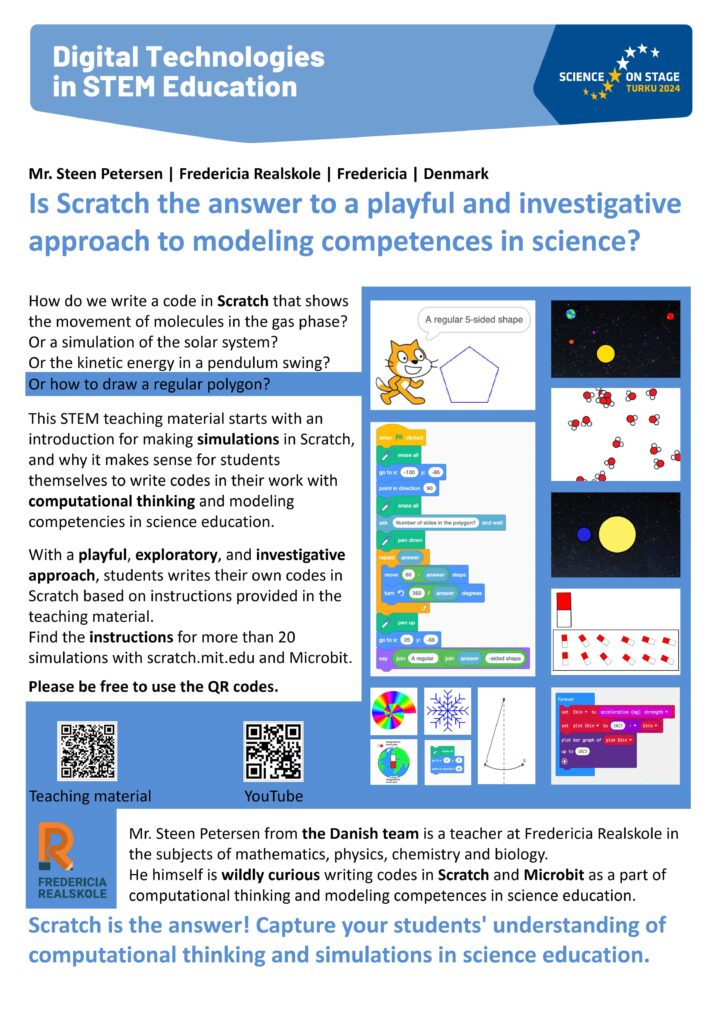
Institution: Fredericia Realskole
Subjects: Physics, mathematics, computer science/ICT/IT
My teaching material is aimed at students in the upper grades (12-16) and consists of short guides to code more than 20 simulations in Scratch and BBC micro:bit.
Let your students code a simulation of a black hole, draw a regular polygon or measure the kinetic energy of a pendulum.
Through a playful and exploratory approach, your students will learn science, math and coding at once.
(T13) NOT School, M. Hanski (FI)
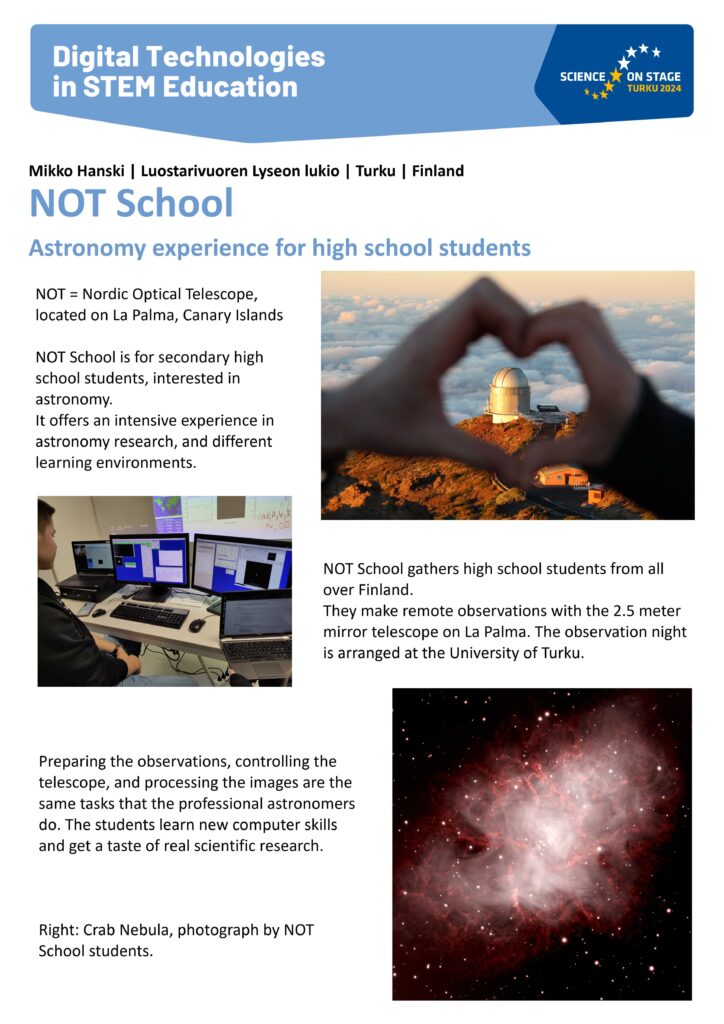
Institution: Luostarivuoren Lyseon lukio
Subjects: Physics, mathematics
NOT = Nordic Optical Telescope, located on La Palma in the Canary Islands. NOT school is for secondary high school students interested in astronomy, physics and natural sciences. It offers an intensive experience in astronomy research, as well as different learning environments. NOT school gathers around 30 high school students from all over Finland. They make remote observations with the 2.5-meter professional mirror telescope on La Palma. The observation night is arranged at the University of Turku. Preparing the observations, controlling the telescope and processing the images correspond to the tasks of professional astronomers giving high school students a taste of real scientific research.
(T14) Fly’n’count – bouncer counter, M. Szekiel-Mnich (PL)
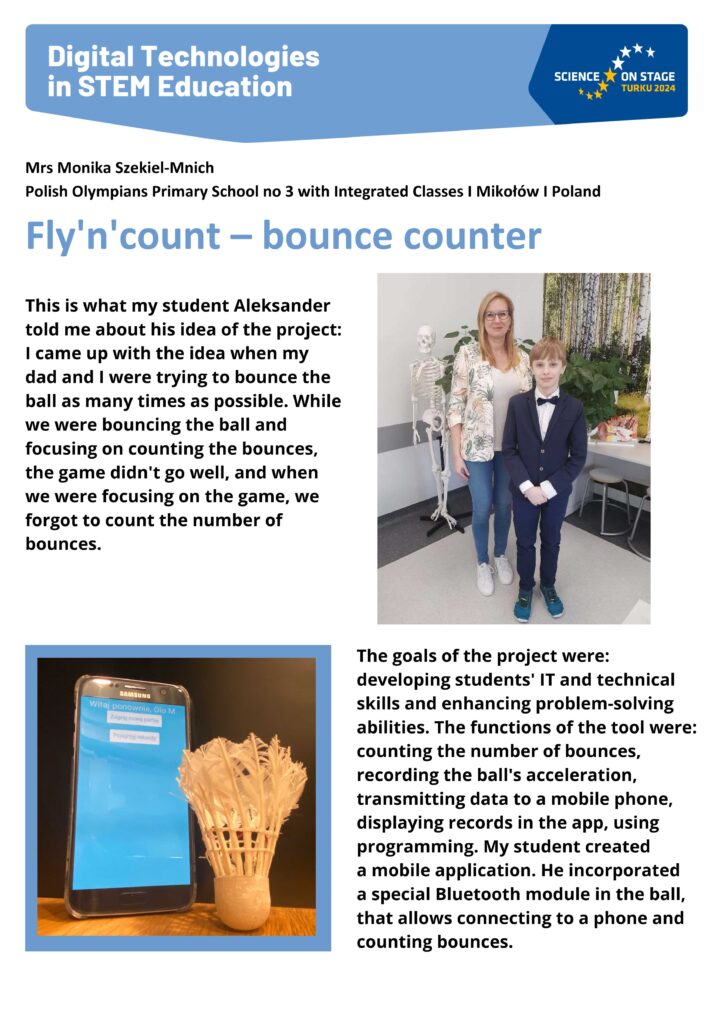
Institution: Polish Olympians Primary School no 3 with Integrated Classes
Subjects: Computer science/ICT/IT, STEM
My student came up with the idea when he and his father were trying to bounce a ball as many times as possible. While they were hitting the ball and focusing on counting the bounces, the game was not going well. However, when they focused on the game, they usually forgot to count the number of hits. Using programming, the student designed and created a mobile application for counting the number of bounces and recording the acceleration of the ball, which transmits data to a mobile phone and displays the recorded data, while a special Bluetooth module that connects to the phone is built into the ball. The aim of the project is to improve students’ IT, technical, and problem-solving skills.
(T16) Transit of an exoplanet: Exoplanet XO-6b size measurements, A. Canela-Xandri (ES)
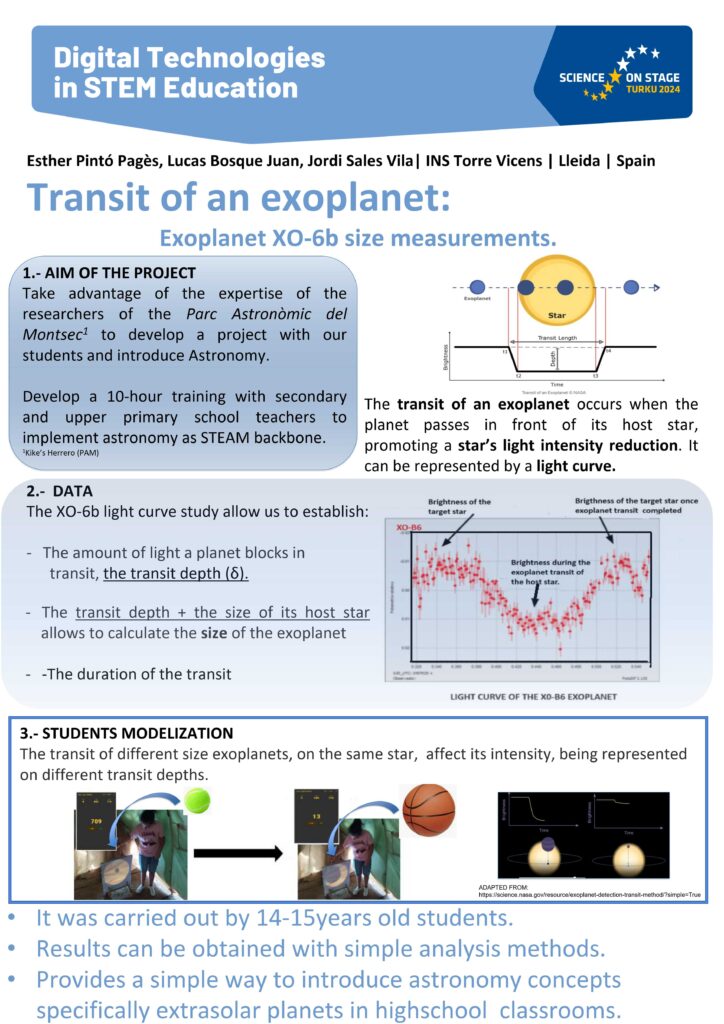
Institution: INS Torre Vicens
Subjects: Physics, astrophysics
The aim of the study was to measure the size and predict the composition and mass of the exoplanet XO-6b, a project carried out with the advice of Kike Herrero. Initially, he provided us with photos of exoplanets that were studied with FotoDif software. We obtained the exoplanet’s transit measurements and calculated its transit light curve. Next, we modeled the exoplanet-star system by making a model designed by 3rd year ESO students. It was used to explain the phenomenon to other students. Finally, to know the mass and composition of the exoplanet, we use telescope lenses that allow us to determine the different compositions through the visualization of strips or areas observed on it.
(T17) AI tutorbot to support learning and teaching, L. Vihma & K. Immeli-Vänskä (FI)

Institution: City of Helsinki, Education Division
Subjects: All
The AI tutorbot acts as a personal assistant and supporter for both learners and teachers. The tutorbot will not provide ready-made answers but has the ability to support learners’ individual learning, e.g. guiding students to the right information, helping them with reading and writing, and translating texts into their native language. The tutorbot can assist teachers in designing teaching modules or preparing teaching materials and learning assignments. During the pilot phase we have gained experiences and lessons on the capabilities and understanding of how to control it.
